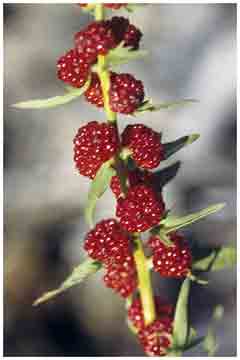

Home | Next | Previous | Index | Purchase book
Idaho Mountain Wildflowers
Goosefoot Family: Chenopodiaceae
The goosefoot family is made up of 97 genera and 1,300 species world-wide, and it is well represented in the United States. Both the common and scientific names were derived from the goosefoot plant, Chenopodium album (chenopodium, from the Greek, means “goose’s foot”), formerly used in Europe as a potherb known as “lambs-quarters” and “fat-hen.” The plant also occurs throughout North America where it is known as the common pigweed. The family is chiefly notable for those species that are important as food plants. These include spinach (Spinacea oleracea) which has largely displaced lambs-quarters as a green; Swiss chard and beets (Beta vulgaris subsp. vulgaris) whose cultivars include both edible beets and sugar beets; blites (formerly included in the genus Blitum, now classified as species of Chenopodium), and the South American cereal, quinoa (Chenopodium quinoa). Some of the Chenopodiaceae are troublesome weeds, including various xerophytic and salt-loving (halophytic) species. Weedy chenopods seem to spring up over night on newly disturbed ground. Many members of the family, including spinach, contain oxalic acid, a substance that can be poisonous if ingested in large amounts; it may also contribute to the formation of oxalate contaning kidney stones.
|
Strawberry blite, Chenopodium capitatum (L.) Ambrosi. (left, right) We have included this plant because it is not well known, and hikers in our mountains will encounter the strawberry blite sooner or later—a plant notable for its fruit rather than for its small and unimpressive flowers (not shown). It is a widely distributed edible native plant that grows at least to montane elevations. Widely distributed, the plant was described by Linnaeus (as indicated by the “L.”following the scientific name). Its species name, capitatum, means “growing in a head,” although why that was used for this plant is uncertain. The word “blite” (sometimes written, incorrectly, as “blight”) is a term that goes back to ancient Greece (bliton) where it may have been used for this plant, and for other edible chenopods. Despite their succulent appearance, its raspberry-like berries are tasteless. |  |
Home | Next | Previous | Index | Purchase book